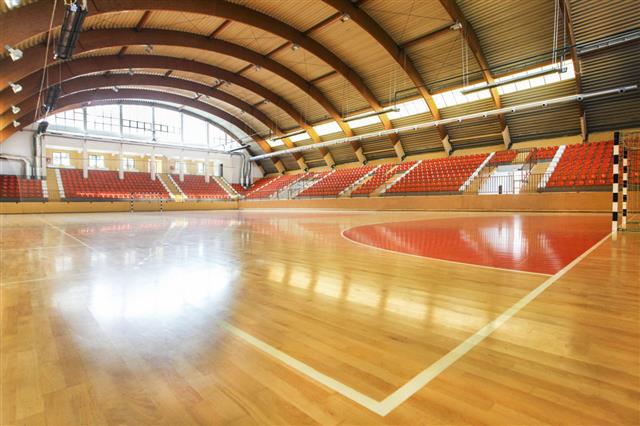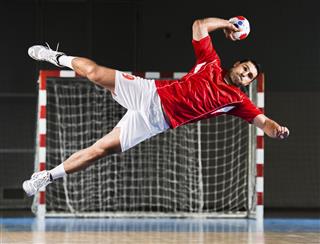
An amazing combination of netball, soccer and basketball, handball is a fast-paced game that requires strength, speed, agility, and team chemistry. With over 150 countries playing this sport internationally, its popularity is rising. Today, it is an Olympic sport and is played internationally with its own World Cup too. It is governed by the International Handball Federation (IHF). There are many rules which are similar to that of basketball and soccer, but many more are unique to this sport.
Did You Know?
In many countries, handball is specifically called ‘Olympic Handball’ or ‘Team Handball’. This is because, it should not be confused with another completely varied version of ‘U.S. Handball’, which requires hitting a small-sized ball with the hand in either a one- or three-walled court.
Dimensions of a Handball Court
- The Court/Field – The dimension of the entire playing field is 131.25 ft (40 m) by 36.62 ft (20 m).
- The Goal – It measures 9.84 ft (3 m) wide and 6.56 ft (2 m) in height.
- The Six Meter Line – This line represents the division between the goalkeeper and the rest of the players.
- The Seven Meter Line – This line is from where penalty shots are taken after fouls are made by players.
- The Nine Meter Line – An arched dotted line is where the attacking team resumes play after being fouled inside the line. It is also termed as a free-throw line.
- Substitution Line – This is an area from where the players should leave the court when a substitution is made.
- Halfway Line/Middle Line – This is a line at the center from where the game begins at the start and after half time, and it is also a spot from where the players restart the game after scoring a goal.
- Goal Area – No player is allowed in this area except the goalkeeper. However, a player can jump into this area as long as he throws and releases the ball before he lands on the floor.
Dimensions of a Handball Court

On-Court Positions

Each team has 14 players, 7 on-field (6 players and 1 goalkeeper) and 7 players who are substitutes. A maximum of 4 officials are allowed per team. The players who get substituted have to leave and enter the court over the substitution line of their respective team. The positions taken up by different players are:
Goalkeeper – He is the only one who can touch the ball with his feet, or for that matter, can defend the goal with any part of the body.
Circle Runner – This player is also referred to as a pivot or line player, and plays along the six-meter line with his back faced to the opponent’s goal. He tries to push himself in between the defenders who queue up on the six-meter line to stop his team from scoring a goal. The pivot has to be quick and create openings for his teammates to get into a better goal scoring position, by stopping the defenders. Therefore, this position is known to be physically tough.
Left and Right Backs – They are usually tall players with good shoulder power, who jump and shoot from over the defenders. They are known to be the long-range handball shooters.
Center Back – A center back is the mastermind behind the game who sets up the maneuvers and the remaining players in the shooting positions. Hence, he is known to be the playmaker or the point guard of the team.
Left and Right Wingers/Outs – These players are usually short but more agile, and score through the angles of the goal post. The right winger is commonly a left-handed player and vice versa, and they are also called the margin side players.
Game Playing
- Double Dribble – Once a player receives the ball, he cannot bounce the ball, then hold it, and bounce it again.
- Kicking – Other than the goalkeeper, no other player is allowed to kick the ball. If the ball touches anywhere on the knee and below, then possession is awarded to the opposition.
- Walking – If a player holds the ball for more than three seconds without shooting, passing or bouncing it, and also if he takes more than three steps without dribbling the ball, then it is termed as ‘walking’, and the ball possession is lost.
- Handball Fouls – Clenching, striking, charging, holding, pushing or tripping is not permitted in this game. However, a player is allowed to catch, stop, throw, hit or push the ball with the help of his hands, thighs, knees, torso, and the head. A player can also move the ball from one hand to another. In case the ball touches the referee on the court, the game continues.
- Six Meter Line – No player is allowed inside the six meter line other than the goalie. Although, while attempting a goal, when the player jumps, he can land inside the 6-meter line only after he releases the ball from his hand.
- Sanctions – The referee can fête a player with either a yellow card (warning, 1/player and 3/team), a two-minute suspension (team has to continue playing minus that one player), or a red card (disqualification, player suspended for remaining of the match).
The ‘Throws’ in Handball
- Throw-off – The team that wins the toss at the start of the game takes a throw-off to begin the game. Both teams should be in their respective halves of the court and at least three meters away from the ball. This process is also repeated after the half-time and after every goal scored.
- Throw-ins – These are awarded when the ball crosses the side line, and is taken by the team who was not the last to touch the ball. The player taking the throw-in keeps one foot on the line from where the ball went out and passes it back to any of his teammates inside the court.
- Free-throws – These are granted for small violations of any rule, and it means that shielders/defenders are supposed to stay 9.84 ft (3 m) away from the player who is taking the free-throw.
- Penalty-throws – A penalty is awarded for some grave violation of any rule or an illegal interference by a defender while a player attempts to score a clear goal.
- Goal-throws – This is awarded to the defending team when the ball crosses the goal line without any hindrance by them. Then, the goalie throws the ball from anywhere in the goal area, to one of his teammates.
- Corner-throws – The attacking side takes a corner-throw when any defender knocks the ball behind the goal line. A player from the attacking side keeps one foot on the corner of the goal line and the side line, and throws the ball to one of his own players.
- Referee’s Throw – The referee bounces the ball to resume the game after any incidental infringement by the players of both the teams.
Game Duration
The Ball
- For men above 16 years, the circumference of the ball is 58 to 60 cm, and the weight is 425 – 475 grams (IHF size 3).
- For women above 14, and male youth in the age group of 12 to 16, it is 54 – 56 cm, and the weight is between 325 and 375 grams (IHF size 2).
- For boys and girls in the age group between 8 and 14 (girls 8 – 14 and boys 8 – 12), it is 50 to 52 cm, and the weight is between 290 to 330 grams (IHF size 1).
Referee
Scoring a Goal
Player Uniform
Fitness Benefits
Handball is known to be famous for its speed, and one can burn over 700 calories per hour playing it. Practicing this game has a variety of health benefits and helps you keep fit, as it…
- …increases flexibility of the body
- …is an excellent cardiovascular workout
- …strengthens the upper body and arm muscles
- …helps in the betterment of the mind and its concentration power
- …improves the flow of oxygen to the muscles through the bloodstream
IHF World Rankings – Top 10
Men’s Category
- Germany
- Sweden
- Russia
- Denmark
- Serbia
- France
- Hungary
- Spain
- Romania
- Croatia
Women’s Category
- Germany
- Russia
- Hungary
- Romania
- Norway
- Denmark
- Serbia
- South Korea
- Poland
- Austria
Brief History of the Game
Handball, also known as Olympic Handball and Team Handball, first originated in northern Europe (Germany, Denmark, Sweden and Norway) at the end of the 19th century. The first game was played in Scandinavia and Germany. Dane Holger Nielsen composed the rules of modern handball in the year 1898. The International Handball Federation was established on 11th July, 1946, with countries like Sweden and Denmark taking the initiative. Apart from these two countries, France, The Netherlands, Switzerland, Poland and Norway were the constituting members of the newly formed federation. The IHF substituted the International Amateur Handball Federation (IAHF), which was constituted in 1928. Since then, this federation has come a long way, and presently, the IHF, which is the governing body of handball, has 163 member federations, and around one million teams under its wing, worldwide.














